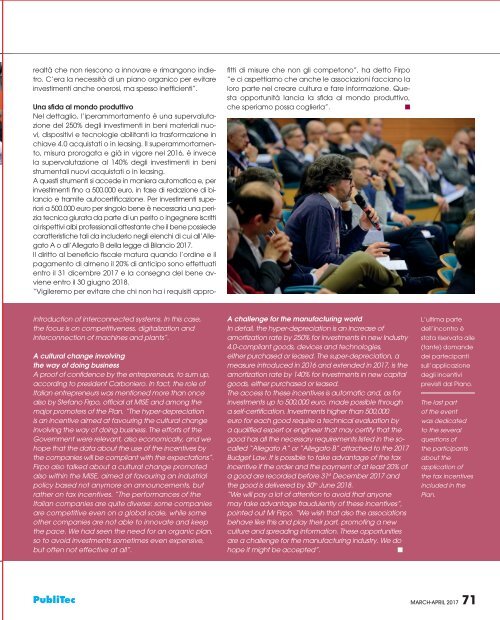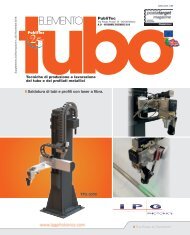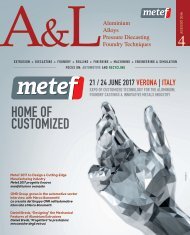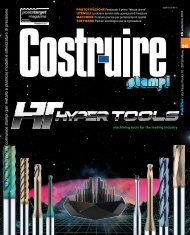ASSEMBLAGGIO_n119_MARZO_APRILE_2017
You also want an ePaper? Increase the reach of your titles
YUMPU automatically turns print PDFs into web optimized ePapers that Google loves.
ealtà che non riescono a innovare e rimangono indietro.<br />
C’era la necessità di un piano organico per evitare<br />
investimenti anche onerosi, ma spesso inefficienti”.<br />
Una sfida al mondo produttivo<br />
Nel dettaglio, l’iperammortamento è una supervalutazione<br />
del 250% degli investimenti in beni materiali nuovi,<br />
dispositivi e tecnologie abilitanti la trasformazione in<br />
chiave 4.0 acquistati o in leasing. Il superammortamento,<br />
misura prorogata e già in vigore nel 2016, è invece<br />
la supervalutazione al 140% degli investimenti in beni<br />
strumentali nuovi acquistati o in leasing.<br />
A questi strumenti si accede in maniera automatica e, per<br />
investimenti fino a 500.000 euro, in fase di redazione di bilancio<br />
e tramite autocertificazione. Per investimenti superiori<br />
a 500.000 euro per singolo bene è necessaria una perizia<br />
tecnica giurata da parte di un perito o ingegnere iscritti<br />
ai rispettivi albi professionali attestante che il bene possiede<br />
caratteristiche tali da includerlo negli elenchi di cui all’Allegato<br />
A o all’Allegato B della legge di Bilancio <strong>2017</strong>.<br />
Il diritto al beneficio fiscale matura quando l’ordine e il<br />
pagamento di almeno il 20% di anticipo sono effettuati<br />
entro il 31 dicembre <strong>2017</strong> e la consegna del bene avviene<br />
entro il 30 giugno 2018.<br />
“Vigileremo per evitare che chi non ha i requisiti approfitti<br />
di misure che non gli competono”, ha detto Firpo<br />
“e ci aspettiamo che anche le associazioni facciano la<br />
loro parte nel creare cultura e fare informazione. Questa<br />
opportunità lancia la sfida al mondo produttivo,<br />
che speriamo possa coglierla”.<br />
n<br />
introduction of interconnected systems. In this case,<br />
the focus is on competitiveness, digitalization and<br />
interconnection of machines and plants”.<br />
A cultural change involving<br />
the way of doing business<br />
A proof of confidence by the entrepreneurs, to sum up,<br />
according to president Carboniero. In fact, the role of<br />
Italian entrepreneurs was mentioned more than once<br />
also by Stefano Firpo, official at MISE and among the<br />
major promoters of the Plan. “The hyper-depreciation<br />
is an incentive aimed at favouring the cultural change<br />
involving the way of doing business. The efforts of the<br />
Government were relevant, also economically, and we<br />
hope that the data about the use of the incentives by<br />
the companies will be compliant with the expectations”.<br />
Firpo also talked about a cultural change promoted<br />
also within the MISE, aimed at favouring an industrial<br />
policy based not anymore on announcements, but<br />
rather on tax incentives. “The performances of the<br />
Italian companies are quite diverse: some companies<br />
are competitive even on a global scale, while some<br />
other companies are not able to innovate and keep<br />
the pace. We had seen the need for an organic plan,<br />
so to avoid investments sometimes even expensive,<br />
but often not effective at all”.<br />
A challenge for the manufacturing world<br />
In detail, the hyper-depreciation is an increase of<br />
amortization rate by 250% for investments in new Industry<br />
4.0-compliant goods, devices and technologies,<br />
either purchased or leased. The super-depreciation, a<br />
measure introduced in 2016 and extended in <strong>2017</strong>, is the<br />
amortization rate by 140% for investments in new capital<br />
goods, either purchased or leased.<br />
The access to these incentives is automatic and, as for<br />
investments up to 500,000 euro, made possible through<br />
a self-certification. Investments higher than 500,000<br />
euro for each good require a technical evaluation by<br />
a qualified expert or engineer that may certify that the<br />
good has all the necessary requirements listed in the socalled<br />
“Allegato A” or “Allegato B” attached to the <strong>2017</strong><br />
Budget Law. It is possible to take advantage of the tax<br />
incentive if the order and the payment of at least 20% of<br />
a good are recorded before 31 st December <strong>2017</strong> and<br />
the good is delivered by 30 th June 2018.<br />
“We will pay a lot of attention to avoid that anyone<br />
may take advantage fraudulently of these incentives”,<br />
pointed out Mr Firpo. “We wish that also the associations<br />
behave like this and play their part, promoting a new<br />
culture and spreading information. These opportunities<br />
are a challenge for the manufacturing industry. We do<br />
hope it might be accepted”.<br />
n<br />
L’ultima parte<br />
dell’incontro è<br />
stata riservata alle<br />
(tante) domande<br />
dei partecipanti<br />
sull’applicazione<br />
degli incentivi<br />
previsti dal Piano.<br />
The last part<br />
of the event<br />
was dedicated<br />
to the several<br />
questions of<br />
the participants<br />
about the<br />
application of<br />
the tax incentives<br />
included in the<br />
Plan.<br />
PubliTec<br />
MARCH-APRIL <strong>2017</strong> 71





